A Tour of the Potosi Mines at Cerro Rico, Bolivia
As the bus wound up the steep brown dusty hills in to Potosi, a thick scent lingered in the air. Petrol mixed what I can only describe as ‘something industrial’. A fragrance I’d never experienced before. One which told my nose that I was about to walk in to unfamiliar and dangerous territory.
The next day I was to undertake a trip in to the working Potosi Mines of Cerro Rico Mountain. An overbearing sight which sits to the west of Potosi and has been mined for over 500 years.
Rich in silver, copper and zinc, Cerro Rico Mine was once responsible for making Potosi the richest town in the world. At least for a time!
Exploitation of workers and resources diverted the profits away from the locals. At the time, the Spanish forced Incas and African slaves to work for them deep underground. The conditions so horrendous that there have been an estimated eight million deaths at Potosi Mine.
Although conditions have improved, Cerro Rico is far from a safe place to be. The average life expectancy of a Potosi Miner is just 45 years. If a collapsed mine doesn’t kill a worker, then noxious poisoning surely will. It might seem hard to imagine why anyone would willingly work in Cerro Rico. Yet with wages in the town of Potosi only averaging B2,000 per month ($289), workers can harness an average income of up to B6,000 ($869) in the Cerro Rico Mine.
Potosi relies so heavily on Cerro Rico, that if it were to ever shut, all it would leave a ghost town.
I wanted to learn more and understand the situation first hand.
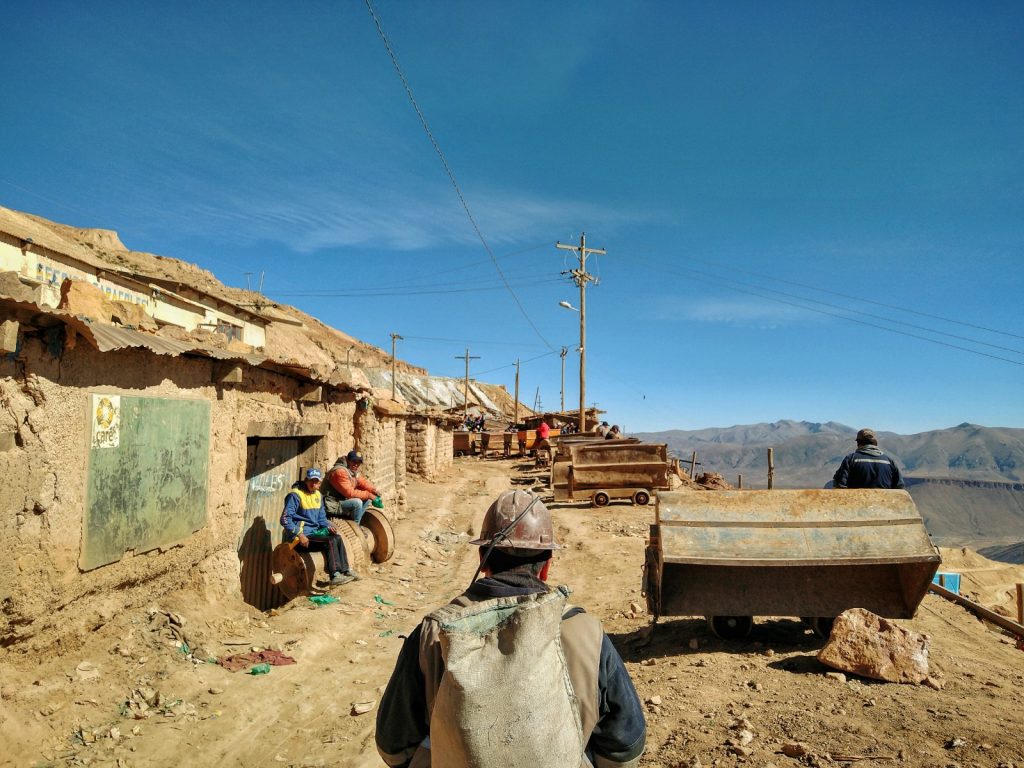
Meeting at the offices of Koala Tours at 8:45 AM, the group jumped in a minibus to a warehouse. We met Ronaldo here. He used to work as a miner in Cerro Rico, before trading in his hammer and chisel to become a guide.
From the moment we met, I could tell Ronaldo was serious. There wasn’t going to be any messing around on his tour. The mines are dangerous and we were going to have to watch our backs down there.
Overalls, boots and helmets fitted, it was time to visit the miner’s market. Here we could purchase gifts for the miners. Ranging from soft drinks to coca leaves, gas masks to sticks of dynamite, it clearly wasn’t a place for tourists.
The miners of Cerro Rico aren’t employed by a large corporation. Each works for himself and will join a cooperative. These cooperatives have an allocated area of the mine and that is where the workers go. With no central employer, each miner must buy their own supplies and equipment. The gifts are greatly appreciated.
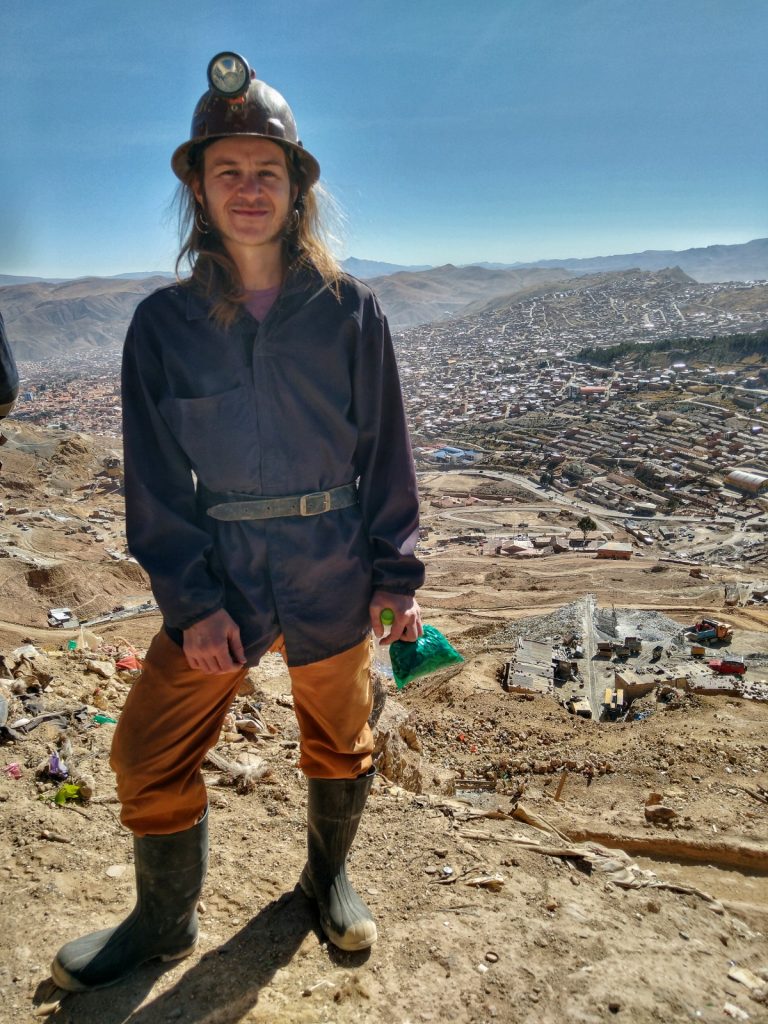
Driving up Cerro Rico, our mini bus went at a speed so slow that it added to my anticipation. There were sheer drops on one side and huge lorries jostling for space on the track. It was simply a warm up for what was to come.
Admiring the views of Potosi town below us, I stuffed my cheeks full of coca leaves and then made way to the entrance. The sun was beating down, but all I could see ahead was a black hole. The dark entrance cut into the rock face with a single track coming out.

“Are we ready? Follow me and keep close” shouted Ronaldo. We ventured in to the black hole. Keeping our heads low to avoid hitting the low hanging rocks.
As my senses adjusted to the dark, I could hear metal rattling. Within about 30 seconds Ronaldo raised his pitch. “Quickly, quickly, follow me, keep up! Get to the left. THE LEFT! The carts don’t stop.”
As the group dived against the wall, a mine cart came hurtling past. Two workers were using all their strength to push three tonnes of minerals and metal out in to the daylight. As the group crouched against a wall, catching our collective breath, Ronaldo asked if everyone was ok.
Not everyone was ok!
Of the seven people that had started just moments ago, three felt it was already time to leave. The plan was to spend at least two hours in Potosi’s Cerro Rico mine, but two minutes had already proved more than enough. A second guide trailing the group led them out and we continued deeper.
Diverting from the path of mine carts, we followed pathways to the owner of the mine. The owner is El Tio. Satan himself!

Surrounded by empty beer bottles and coca leaves, El Tio lives near the entrance of the mine. Workers bring him offerings to keep them safe from harm. Cigarettes, alcohol and coca leaves are all used to ask for his blessings.
Ronaldo sat us down by El Tio and asked us to turn off the lights on our helmets. As he explained the history and workings of Cerro Rico, a girl from the group sat crying. Asking to leave, Ronaldo’s assistant led her down the dark passage.
Two minutes later they both returned. The girl now looking even more dishevelled. Her exit from the mine was blocked by workers filling a cart full of minerals from an overhead shaft. This is the miners’ territory and there’s no way to get past. You can’t politely ask them to move as you’ve come for a real world experience and realised it was the wrong thing to do.
Sitting in darkness, Ronaldo said we would need to put out hard hats back on and wait a while. He had received the signal that the workers filling the mine cart were about to detonate some dynamite.
This was no joke. As the detonation took place, the walls vibrated and I heard crumbling rocks falling from the rafters.
With minerals extracted, the girl was now free to leave.
We were now a group of three.
“I bet you’ll appreciate your jobs when you get home” said Ronaldo. Not a hint of irony or humour in his voice.
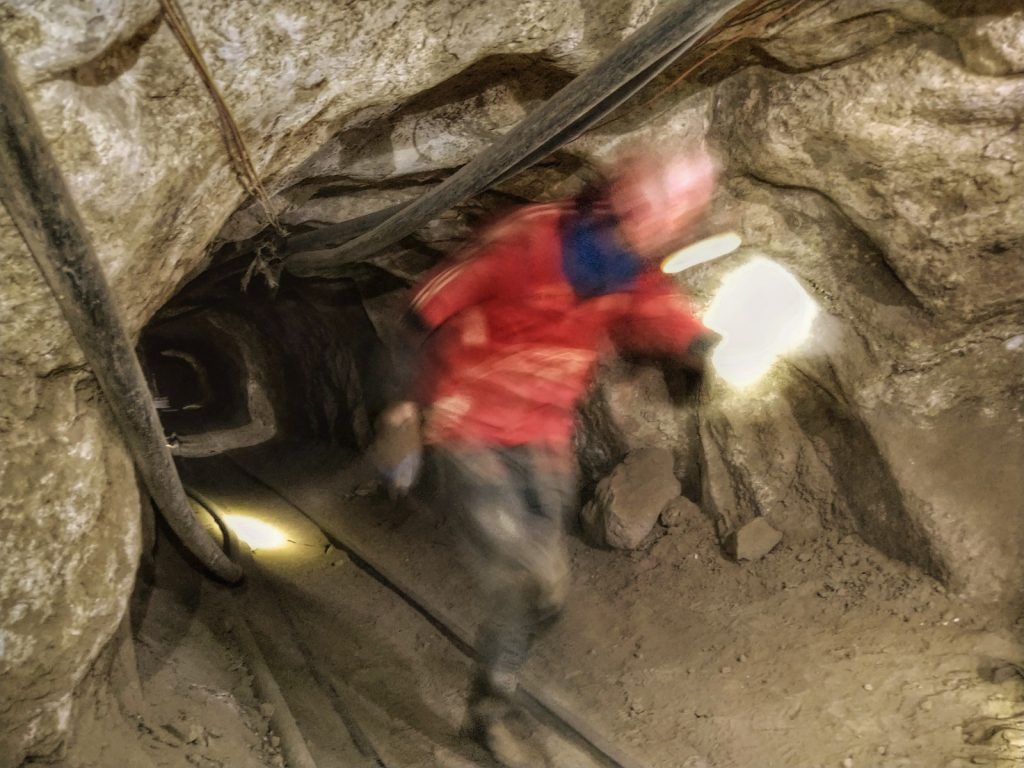
“We’re now going to go down a level in to the mine. There are four in total and we’ll be going down another two.”
For the uninitiated Gringo, there didn’t appear to be a path down. Ronaldo pointed to a small hole. “Follow me and do as I do.”
With those words he disappeared.
Following his lead, I bent my arms around an old plank of wood and went feet first into the darkness. Grabbing at the walls as I went, my feet pushed through the gravel below, sending rocks hurtling ahead. It was at this stage that a lifetime of yoga would have paid off. Stretching one leg in the opposite direction to the other, like Spider-Man I pinned myself to the walls and hoped to El Tio that I wouldn’t fall.
As the group stood at the bottom of the shaft, I thought this was it. “Ok follow me again” blurted Ronaldo. He pointed to an opening at the base of a rock that couldn’t be more than 30cm in height and 60cm wide.
Feet first he disappeared. I looked ahead and thought this must be a joke. That Ronaldo was just testing us to see if we’d do anything he said. The claustrophobia in me started to build, but before I could give it too much thought, I went ahead.
Dropping to my knees, I stretched out my legs and wriggled feet first into the abyss.
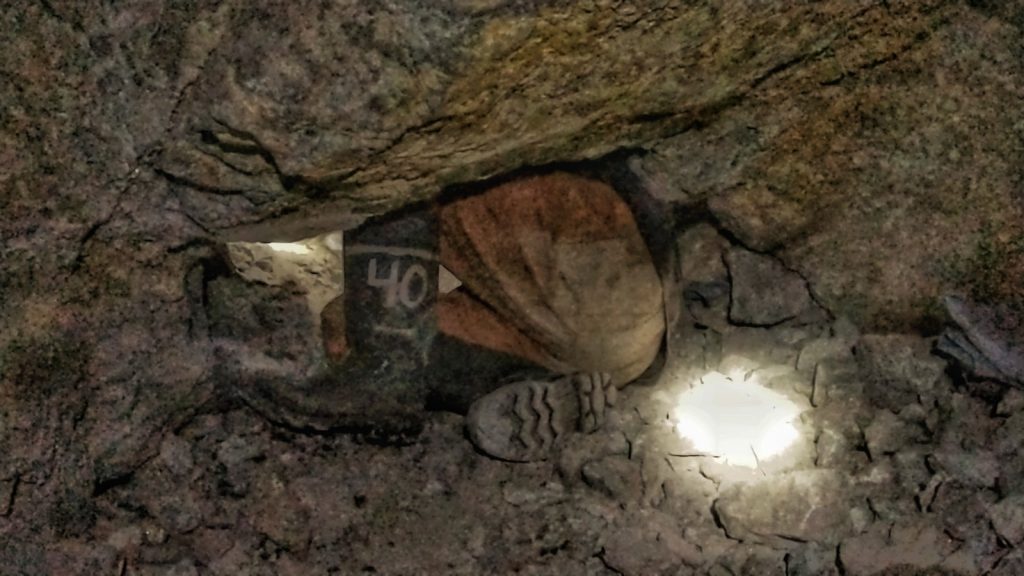
On the inside was just enough room for us to crouch and a miner hammering away at the wall with a chisel. Ronaldo spoke to him in Spanish and asked questions. How many hours he would work for that day, the number of years spent in Cerro Rico mine, his age and what equipment he needed.
Dynamite was of great importance and so Ronaldo passed on some of our gifts from the miners market.
We moved on, through the narrow hole and back up the shaft which we had descended. At the top we witnessed a worker assembling dynamite. He was 24 years old and had already been working in Cerro Rico for six years. Pulling apart the stick and stuffing the powder in to plastic bottles, he was making enough for a series of small explosions. Ronaldo pointed to the wall. Following the lines like veins, this was where dynamite would be placed to extract the most minerals.
Trudging through a labyrinth of endless tunnels we descended to another level. A wooden ladder with missing steps helped us at first, but then things got real. The group had to walk the plank. An old thin piece of wood was all that covered a drop in to a black hole.
With more bending of the body into incomprehensible positions, I climbed into a narrow passageway. At the end we saw two more workers. Ronaldo knew them and talked freely, as they took chunks of rock and smashed them with hammers.
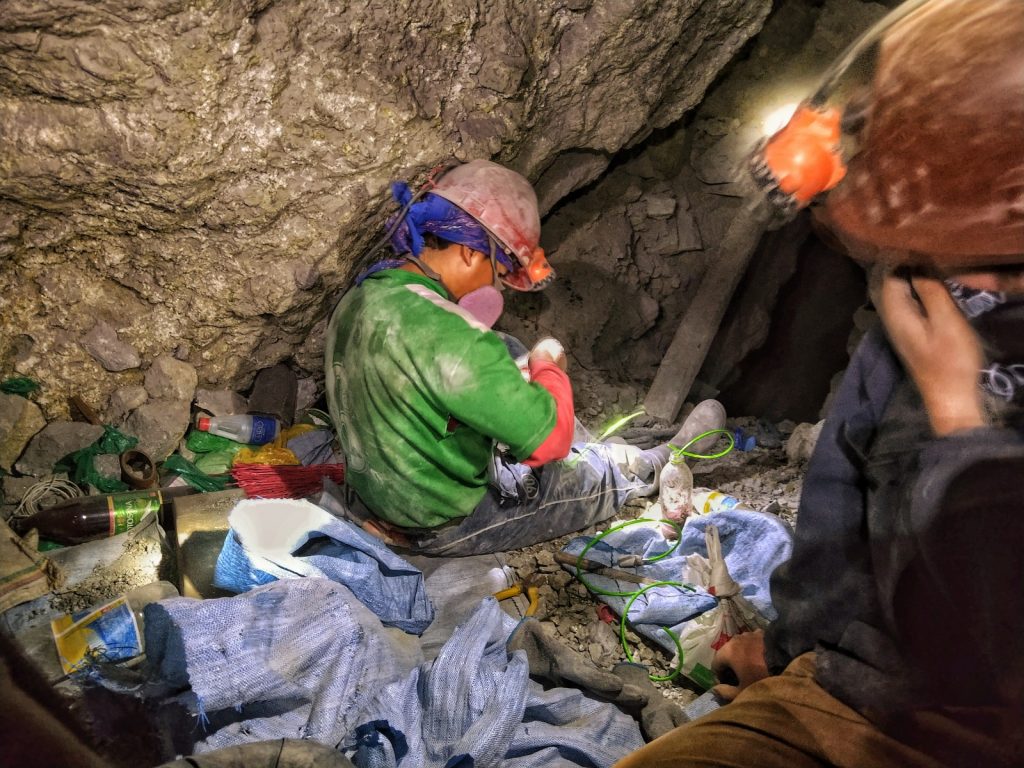
Welcoming conversation, but never looking up to stop work, these workers had been in the mine since 7AM, planning to leave at 4PM. Surrounded by sacks and buckets, they’d already gathered over 60kg of useful minerals from which silver could be extracted. To get the minerals out the mine, they would carry the 60kg sack on their backs and through the narrow passageway that we had just come.
I couldn’t carry 60kg at any time of day. But through a narrow mine in the dark? These workers’ determination and strength was like nothing I’d ever experienced.
Giving gifts and moving on, I couldn’t help but feel redundant. I hadn’t come to gawp, nor had I come to help. I just wanted to learn about how people live and better understand life in another part of the world. It was the closest I could get to a real world understanding, without being part of a film crew sent to go and investigate.
Yet it didn’t make a difference. Here they were living their lives and here I was observing. Ronaldo did emphasise early on that the miners are happy for the tourists. It provides money to their cooperative and the gifts reduce their daily costs. It provides some light relief, but after two hours I was starting to feel like I may be regarded as a voyeur.
It came at a good time that Ronaldo announced we would now be leaving. Although it wasn’t easy to leave. The time was 1PM and the workers were starting to remove their minerals.
Mine carts were hurtling down every passage way and we remained pinned to the wall. A brief moment would allow us to make some ground, but we were soon pinned to another wall. At one point, Ronaldo had to physically push us back. It seemed like an aggressive move when we were in the requested position, but seconds later it all made sense.

A thundering crash like I’ve never known came inches from my feet. A mine cart lay on the floor inches away. When two carts are on the same path, one has to give way. This one was thrown off the tracks in our direction. The space between the wall and the other side of the track was just too thin, so the cart came out way.
Making a final judgement call, Ronaldo led us to the light at the end of the tunnel. As we exited, there was an air of relief. Ronaldo said we had survived.
Simply tourists for the day, we had survived an ordeal that the mine workers of Cerro Rico go through every single day. It was the most eye opening real world experience I’ve ever had.
How to book a Potosi Mines Tour of Cerro Rico
In Potosi town there are plenty of mine tours to choose from. You can contact a tour company in advance, or book upon arrival.
I advise to go with a company that visits the actual Cerro Rico mines (not a tourist mine). In addition, it’s important to go with a company that’s interested in the welfare of the miners.
I booked a Potosi Mines tour with Koala Tours. This is because part of the funds go back to the miners. Working in Cerro Rico isn’t an easy life and everything that can help the miners is worth supporting.
Having a tour guide with experience is really important. The guide for our group used to work in the mine and paid great attention to the surroundings to ensure our safety,
Koala Tours also had thorough safety briefings and good equipment. The lights on the helmets worked, the group were given suitable boots and clothes too.
Don’t forget to bring a dust mask, or purchase one at the miner’s market. Many of the tour companies also sell cheap branded bandannas to cover your mouth.

Are the Potosi Mine Tours Safe?
In summary, the Potosi Mine Tours are not safe. Although that doesn’t mean you will get injured or come to any harm. It’s important to realise that these are real working mines and you must keep your wits about you at all times. The guide should also have your safety as their main priority, but your due diligence plays an important part.
Before commencing a Potosi Mine Tour you will also have to sign something which says you understand that if you die, it’s not their fault.
You have been warned!
Get the best value accommodation in Potosi here:
SHARE OR PIN THIS POST